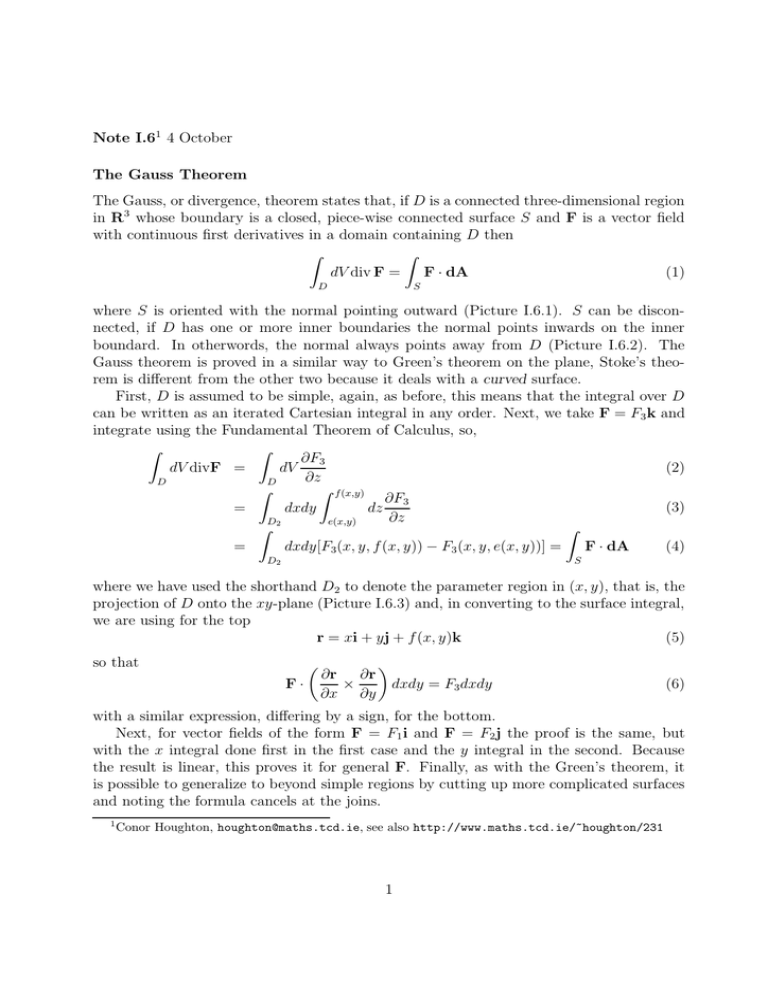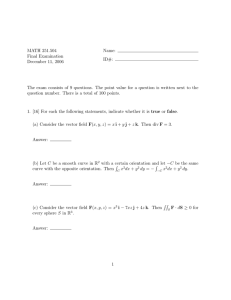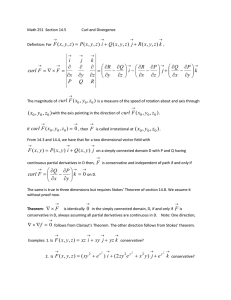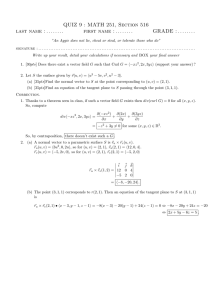4 October Note I.6 The Gauss Theorem
advertisement

Note I.61 4 October The Gauss Theorem The Gauss, or divergence, theorem states that, if D is a connected three-dimensional region in R3 whose boundary is a closed, piece-wise connected surface S and F is a vector field with continuous first derivatives in a domain containing D then Z Z dV div F = F · dA (1) D S where S is oriented with the normal pointing outward (Picture I.6.1). S can be disconnected, if D has one or more inner boundaries the normal points inwards on the inner boundard. In otherwords, the normal always points away from D (Picture I.6.2). The Gauss theorem is proved in a similar way to Green’s theorem on the plane, Stoke’s theorem is different from the other two because it deals with a curved surface. First, D is assumed to be simple, again, as before, this means that the integral over D can be written as an iterated Cartesian integral in any order. Next, we take F = F 3 k and integrate using the Fundamental Theorem of Calculus, so, Z Z ∂F3 dV divF = dV (2) ∂z D D Z Z f (x,y) ∂F3 (3) dz = dxdy ∂z e(x,y) D2 Z Z = dxdy[F3 (x, y, f (x, y)) − F3 (x, y, e(x, y))] = F · dA (4) D2 S where we have used the shorthand D2 to denote the parameter region in (x, y), that is, the projection of D onto the xy-plane (Picture I.6.3) and, in converting to the surface integral, we are using for the top r = xi + yj + f (x, y)k (5) so that F· ∂r ∂r × ∂x ∂y dxdy = F3 dxdy (6) with a similar expression, differing by a sign, for the bottom. Next, for vector fields of the form F = F1 i and F = F2 j the proof is the same, but with the x integral done first in the first case and the y integral in the second. Because the result is linear, this proves it for general F. Finally, as with the Green’s theorem, it is possible to generalize to beyond simple regions by cutting up more complicated surfaces and noting the formula cancels at the joins. 1 Conor Houghton, houghton@maths.tcd.ie, see also http://www.maths.tcd.ie/~houghton/231 1 Examples and Applications of the Gauss Theorem • One important consequence of the Gauss theorem is that, if the flux of a smooth vector field out of any closed surface is zero it can be concluded that F is solenoidal. This applies, for example, to incompressible fluid flows and to magnetic flux. • The Gauss theorem is used in deriving properties of partial differential equation, the uniqueness of solutions to the Laplace equation with Dirichlet or van Neumann boundary conditions for example. • In actual calculations, it is sometimes worthwhile to use Gauss’s theorem to convert a two-d integral into a three-d one, or visa versa. Similarily, it allow the volume of a region to be calculated as a surface integral, Z Z 1 V = dV = r · dA (7) 3 δD D since div r = 3. It is also interesting to note that the Fundemental Theorem of Calculus, Green’s Theorem, Stoke’s Theorem and Gauss’s Theorem, are all special cases of a more general result, valid for flat and curved regions in an arbitrary number of dimensions, called the generalized Stoke’s Theorem. Using differential forms this result can be written as Z Z dF = F (8) D δD Vector potentials Recall that if curl F = 0 in a simply-connected region then F is conservative meaning there exists a scalar potential φ such that F = grad φ. There is a similar result for solenoidal vector fields: if div F = 0 in a region without inner boundaries there exists a vector field A such that F = curl A. A is called a vector potential for F. For example if F = B a constant vector then 1 A = (B × r) (9) 2 is a vector potential for F. It is easy to see that F = curl A has zero divergence, the converse is trickier and will not be proven here. Rather a, constructive, proof is given for the special case of a star-shaped region. A region D is called star-shaped if it has a point O such that the line-segment joining O and any other point in D lies within D (Picture I.6.4). If D is star-shaped there is a formula for the vector potential for a solenoidal vector field given by Z 1 A(r) = 0 dt F(tr) × tr. 2 (10) where the point O in D is taken to be the origin (r = 0). To prove this is a vector potential for F we have to show that taking the curl of the right hand side reproduces the original vector field F. We have Z 1 curl A(r) = dt curl (F(tr) × tr) . 0 Using the vector identity ∇ × (F × G) = (∇ · G)F + (G · ∇)F − (∇ · F)G − (F · ∇)G (11) curl (F(tr) × tr) = 3tF(tr) + t(r · ∇)F(tr) − 0 − t(F(tr) · ∇)r, (12) we have using div r = 3 and div F = 0. A straightforward calculation gives (F(tr) · ∇) r = F(tr) (13) We also require (r · ∇)F(tr) = t or ∂ ∂ ∂ +y +z x ∂x ∂y ∂z d F(tr), dt F(tx, ty, tz) = t d F(tx, ty, tz), dt (14) (15) which is a generalisation of d d g(at) = t g(at). da dt Inserting these two formulae into the expression for curl (F(tr) × tr) gives Z 1 Z 1 d 2 2 d dt curl A = dt 2tF(tr) + t F(tr) = t F(tr) = F(r), dt dt 0 0 a (16) (17) using the Fundamental Theorem of Calculus. Note that the vector potential for a solenoidal vector field is not unique; if A is a vector potential for F then so is A0 = A + grad φ, (18) where φ is any scalar field since curl grad φ = 0. (19) In electromagnetic theory this ambiguity is called gauge freedom and transforming A to A0 is called a gauge transformation. We have seen that in a simply-connected region an irrotational vector field can be written as a scalar and in a region without inner boundaries, though the proof was only given for star-shaped regions, a solenoidal vector field can be expressed as a curl. Now if F is neither solenoidal nor irrotational it can be decomposed into a gradient and a 3 curl. There are a number of versions of this statement and they go under various names such as the Fundamental theorem of vector analysis, Helmholtz’ theorem and the Hodge decomposition. Here we give a simple version of the decomposition theorem: any vector field F defined in a region D without inner boundaries can be written F = grad φ + curl A (20) To see how a proof works, assume that F is not solenoidal and consider F − ∇φ where φ is, for now, any scalar field. We have div (F − ∇φ) = div F − ∇2 φ. (21) Now if there exists a scalar field satisfying the equation ∇2 φ = div F (22) then F − ∇φ is solenoidal in D and so we can write F − grad φ = curl A. (23) To complete the proof we need to show that 22 always has a smooth solution φ. This equation is actually a form of Poisson’s equation and will be discuss later in the course. Integrating scalars in two and three dimensions We have defined line and surface integrals of vector fields; it is also possible to define line and surface integrals of scalars, these haven’t the same impressive integral theorem results as the integrals of vector fields, but are sometimes useful. We write Z Z dlφ = |dl|φ (24) ZC ZC dSφ = |dS|φ (25) S S (26) where we can define these quantities as some sort of infinitessimal limit of a sum, as we did for the line and surface integrals of vector fields (Picture I.6.5). We can also rewrite these integrals in parametric form, this is easy since we have already seen how to express dl and dS in parameteric form. Hence, if a curve C is parameterized by r(t) Z Z t2 ∂r dtφ(r(t)) dlφ = (27) ∂t C t1 4 where r(t1 ) and r(t2 ) are the end points of the curve. Similarily, for a surface parameterized by r(s, t) Z Z ∂r ∂r dSφ = dsdtφ(r(s, t)) × (28) ∂s ∂t S As an example, lets work out the circumference of an ellipse, working out the length by integrating φ = 1 Z L= dl (29) C where C is the ellipse x = a cos t y = b sin t (30) (31) ∂r = −a sin ti + b cos tj ∂t (32) so r = a cos ti + b sin tj and giving r p 2 2 ∂r = a2 sin2 t + b2 cos2 t = a 1 − a − b cos2 t ∂t a2 (33) and, assuming without loss of generality, that a > b we define the eccentricity e2 = a2 − b 2 a2 (34) which gives a measure of how round the ellipse is, for e = 0 it is a circle, for e → ∞ it approaches a line, and get Z 2π √ 1 − e2 cos2 t (35) L=a 0 This integral is the elliptic integral of the second kind: L = 4aE(e) (36) In otherwords, we define a new function by this integral. It is one of a class of integrals and functions used to solve elliptic problems, such as the motion of a pendulum or of a ball rolling on the inside of a sphere. 5






